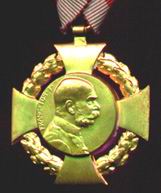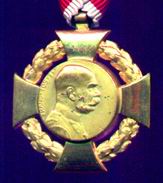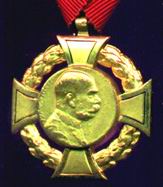 |
 |
 |
 |
| Obverse | Revers | Variant 1 | Variant 2 |
The Crown Jubilee Crosses of 1908
On the 2nd of December 1908 Kaiser Franz Joseph I celebrated his 60th Crown Jubilee. In a similar fashion to the celebrations held ten years previously, special commemorative decorations were instituted and awarded to honor all manner of service to the Kaiser and the country. The decoration itself was designed by the famous medal designer Kammermedailleur Professor Rudolf Marschall (1873-1967) and was based on a so-called Tatzenkreuz (a cross similar to that used by the German Iron Cross), of about 37 mm diameter, with a wreath of laurel leaves between the arms. On the obverse the cross bore a round centerfield, about 20 mm in diameter, depicting a portrait of the Emperor's head and on the viewer's left side the small inscription "FRANC.IOS.I." and - only in some cases - on the right side the very small designers mark "R.Marschall". On the plain rear side the two years "1848 - 1908" on two lines.
These crosses were made of gold plated brass by many different firms over several years in large quantities so it is little wonder that several variant patterns do exist on today's collector market. For example they can vary from 36-37 mm and from 25,8 to 26,8 g but in the final analysis each collector himself has to decide which is a variant pattern and which is not. There are only 2 clear variant patterns which can be verified by contemporary black and white photographs: Variant 1 with highly polished cross arms like small mirrors and Variant 2 with an additional engraved line along the outer side of the cross arms - some manufacturers additionally inlaid this engraved line with black enamel to achieve a better appearance.
The award of such a cross was entered into the personal files and displayed on the decorative retirement documents ("Abschied") if these were awarded on an individual's retirement. However a specific award certificate was not issued on the bestowal of the award. The crosses were normally presented without boxes or wrappers but the different firms sold innumerable variants to account for individual taste and expenditure. It should be noted that these crosses were so common and also so inexpensive that most of the recipients obtained one and often additional crosses at their own expense.
Jubilee Cross for military-personnel (Militär-Jubiläumskreuz)
Instituted on the 10th of August 1908 (published on the 18th of August 1908) for all members of the armed forces. The cross was worn on a typical tri-fold 40 mm wide white ribbon with red stripes at the edges - the stripes are 5 mm wide and 3 mm inside the outer edges. This cross was presented to all officers, military officials and soldiers who had a minimum of 3 years of service on a professional status during the period between the 2nd of December 1898 and the 2nd of December 1908, also to all personnel who had taken part in a minimum of one engagement during the 1848/49 war and to all persons, including the civil employees at several military schools, cadet institutes and military orphanages, who were on active duty on the 2nd of December 1908 on a professional status. It was additionally awarded to all those on duty on that day on a non professional status who had received a minimum of 2 years of military training. This last paragraph specifically referred to the students of officer aspirant schools from the 2nd class onwards and aspirants for any reserve rank from the normal levy of "universal conscription" who were in their 2nd or higher year of duty (Zweites Präsenzjahr).
On the 31st of December 1914 Kaiser Franz Joseph addressed the men of his army and navy in order to express his appreciation and decided (published on the 6th of January 1915) that all officers and officials of the reserve (or any other similar status) who had participated in the current war and who had already possessed the status of an officer (or official) on the 2nd of December 1908 and had not received the Militär-Jubiläumskreuz before, should now also receive this cross as a special honour. This sounds a little complicated but is explained by the fact that in 1908 only the professionals received the cross whilst this new regulation also included all those from the body of the reserve who had as a minimum requirement the rank of Leutnant before the 2nd of December 1908 - this was de-facto the group of Oberleutnants and Hauptmann/Rittmeister der Reserve who became more and more important during the great war!
The authorities had learned from the experiences with the jubilee medals of 1898. Ten years before a comparable series of medals had been instituted but it had not been considered at the time that an individual could fulfill more than one condition of service and consequently many personnel had received two or even all three medals for the same jubilee! This was not considered fair and of course was detrimental to the small decorations budget! In 1908 any double awards were avoided by declaring the military cross as the highest, the civilian cross as the medium and the court cross as the lowest grades of the decoration and by regulating the award criteria so that an individual could only receive the "highest" cross for which he fulfilled the necessary qualifications!
Jubilee Cross for civil-officials (Jubiläumskreuz für Zivilstaatsbedienstete)
Instituted on the 14th of August 1908 (published on the 16th of November 1908) for all officials of any civilian branch of service. The cross was worn on a typical tri-fold 40 mm wide plain red ribbon. This cross was awarded to all male or female officials of all branches of the civil service (with the exception of the ministry of foreign affairs) and employees and workers of state owned companies who were on active duty on the 2nd of December 1908 and had a minimum of 3 years of service and to all those who were not on active service on that day but had fulfilled as a minimum 10 years of service during the period between the 2nd of December 1898 and 1908. In all cases the individual had to be over 21 years of age. If the recipient had qualified for the military cross, the award of the civilian cross was not permitted..
Jubilee Cross for court-servants (Jubiläums-Hofkreuz)
Instituted on the 20th of September 1908 (published on the 16th of November 1908) for all officials and servants of any branch of the court service. The cross was worn on a typical tri-fold 40 mm wide red ribbon with white edges. Similar to the court jubilee medals of 1898 the colour of the ribbon was not as bright as that used on the plain red ribbon above and was in fact the so-called "ponceaurot" which was also utilized as the ribbon of the Order of Leopold. This cross was awarded to all ranks, male and female, of the Ministerium des k.u.k. Hauses und des Äußeren (ministry for court and foreign affairs) who were on full time duty with a minimum of 3 years of service and over 21 years of age. To the court also belonged the members of the Hof-Theater and -Opera, the employees of the hunting grounds, those officials of the postal service who were employed at the court telegraph office, all those clergymen employed at any court churches or chapels and all members of the different lifeguards. For all those who were not on active duty on the 2nd of December 1908 the following rule applied: all officers, officer equivalent officials and priests who had 3 years of service during the period 1898 and 1908 could receive the cross - all non officer equivalent soldiers and servants only when they had left the court service after the 1st of December 1907. If the recipient had also qualified for the military cross or for the civilian cross, the award of the court cross was disallowed.
 |
 |
 |
 |
| Obverse | Revers | Variant 1 | Variant 2 |